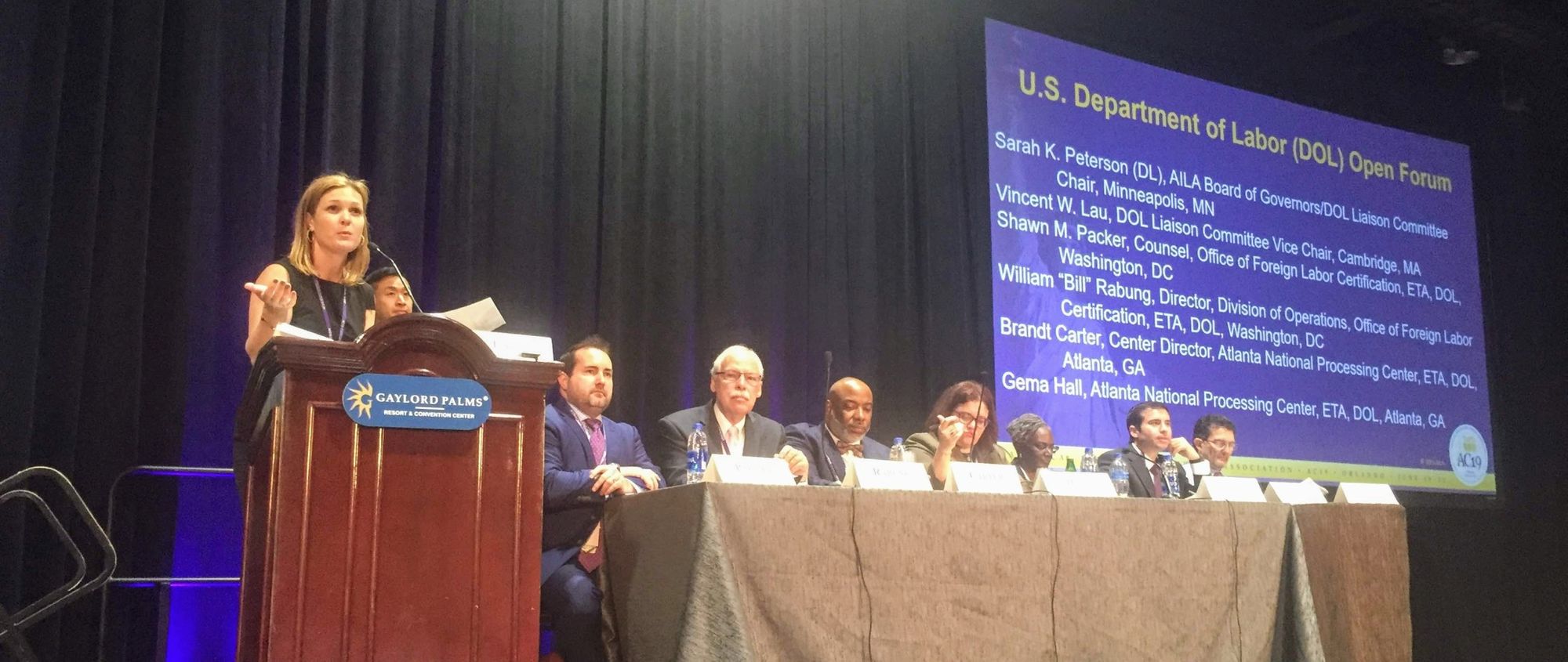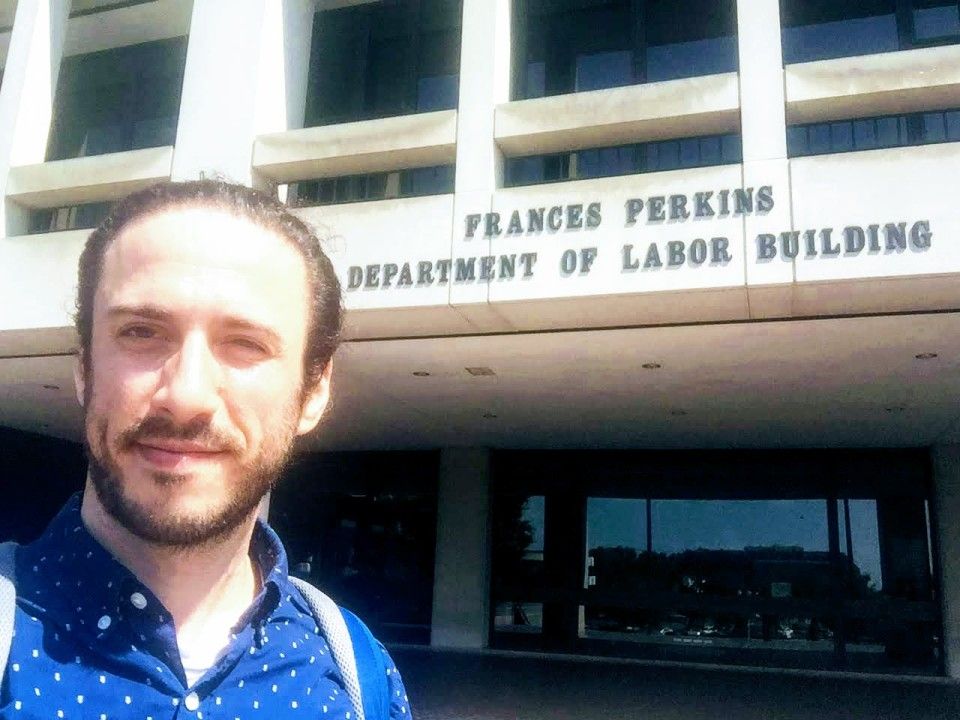From the very beginning of my immigration tech startup journey, I’ve been trying to get in touch with the federal government. Specifically the US Department of Labor (DOL). Not investors. Not prospective clients. Not even former immigration law colleagues to hear my crazy idea. Instead, from day one, I wanted to go straight to the source.
You see, the startup I’ve built, LaborLess, automates the Labor Condition Application (LCA) compliance process for companies who hire H-1B workers, and the DOL is the department that wrote the rules on this compliance process. So if I could just get in front of them and tell them about my idea, I thought, maybe then I’d quit my full-time job and start working on it.
Eventually this is exactly what I did, though not quite how I had planned. Here’s how it happened.
Staying in touch with high school friends is always a good idea
When I first started thinking about the LaborLess concept and working on it at a high level, I immediately emailed DOL’s technology support team to see if I find my way to someone who knew something about electronic LCA posting. I got a few generic email replies, but it was effectively radio silence. I had heard from a few lawyers I spoke to that the DOL issued “Opinion Letters” to folks inquiring about specific fact patterns related to their regulations, but when I looked into it further I learned DOL had discontinued the practice by then (though it’s actually back now).
Two strikes. Ok, what else could I do?
I dug through my close connections at the federal government, but no one knew how to put me through to the DOL, let alone the department’s Wage and Hour Division (WHD), which was the specific team within DOL I was interested in talking to.
Strike three. Good thing I don’t play baseball, though, so I pushed ahead.
I finally made a plea to my broader social network, asking if anyone I knew could connect me with someone, anyone, at the DOL. I didn’t have high hopes for this, but this is the beauty of social media. A friend I hadn’t spoken to since high school responded - she had worked in the federal government for a bit, though at a different department, but knew some people at DOL, specifically at WHD! She offered to connect me to a friend who knew something about the LCA process.
After weeks of coordinating, I finally got a short call with her friend at DOL. It was, of course, unofficial, but I was able to talk through my idea. I shared my immigration law background, explained how I found the LCA process to be painfully manual, and described the tech solution I envisioned that, I argued, would digitize and streamline the entire LCA process, saving hours and hours of manual work for immigration teams and making life easier for the DOL during LCA audits.
When I was done, I asked, “so, what do you think?”
“Well,” my new DOL contact started to answer, “this is my personal opinion and in no way reflects the opinion of the federal government.” Then a long pause. I felt stupid being nervous, but I couldn’t help it.
She went on, “but, I think this is a great idea, and exactly the kind of innovation that will help push the immigration practice forward. Keep at it!!”
I was elated. We spoke for a few more minutes, and then after I had used up my allotted 15 minutes, I thanked her profusely and ended the call.
As I said, this was completely unofficial and based on one person’s personal opinion. But with the help of my good friend confirmation bias, this was all I needed.
Six months later, on June 30, 2017, I left my full-time job and jumped head-first into LaborLess.
Starstruck at the 2019 AILA annual conference
Fast forward two years, to June 2019. I’m walking the halls of the air-conditioned Gaylord Palms resort in otherwise sweltering Orlando, Florida at the 2019 American Immigration Lawyers Association (AILA) annual conference. I was sporting a LaborLess t-shirt and long hair tied up into a bun amongst a sea of prim and proper suits.
The AILA conference was a wonderful experience and an incredible opportunity to network, catch up with old friends and colleagues, and meet up with folks I had only known virtually but never met in person. I also got a chance to learn about and review a handful of immigration tech products, which was really interesting and provided great insight into the direction of technology in the immigration space.
But the REAL reason I was at the AILA conference was to learn about the LCA directly from the DOL - after all, I’ve built an entire startup around automating the LCA process. Specifically, I wanted to attend two particular sessions - one about DOL’s new Foreign Labor Application Gateway (FLAG) system and another an “open forum” of DOL staff, including folks from WHD.
One of the panelists at the DOL open forum was Keith Sonderling, Acting Administrator of the WHD.
More importantly, at least to me, he was the government official who signed off on guidance that DOL released just a few months prior to the conference (March 15, 2019, to be exact) providing clarity around digitizing the LCA process.
In other words, this was the person who made official what I had been thinking and working on for years - the idea that automating the LCA process through electronic posting, specifically online LCA posting, is perfectly compliant!
I sat in the front row of both DOL sessions, sporting my LaborLess t-shirt, taking copious notes and asking questions whenever possible. The open forum DOL session, specifically, was incredibly insightful. Not only did the speakers talk about how the department is run and some of the exciting things they’re working on such as process modernization, they were also honest and open about some of the challenges they’ve faced over the years including insufficient staffing in the face of rising popularity of certain visa categories.

After the session was over, I ran up to Mr. Sonderling as he was walking out like a die-hard fan at a rock concert. I introduced myself and then must have spoken a million miles an hour - telling him who I was, my background as a lawyer, how excited I was about the recent online LCA posting memo, and how I quit my job to build a startup around his team’s regulatory guidance.
If I had a printout of the DOL memo, I probably would have asked him to autograph it.
Despite my craziness, Mr. Sonderling was incredibly kind. He listened to my spiel, and actually seemed really excited that I had cared so much about their recent guidance, and the LCA process in general, to have built an entire software solution around it.
But the next thing he said completely stopped me in my tracks.
“Would you want to come to DC and demo your startup to my team?” He asked.
The last two and a half years flashed before my eyes. “Of course, I’d love to!” I responded without thinking. I wasn’t sure when, or how, or for how long, but this was literally what I had been dreaming about for years. I handed Mr. Sonderling my card, which had my email address on it. He said I’d hear from him shortly.
Two days later, on Monday, June 24, 2019, I got a call from the Department of Labor to schedule a meeting with Mr. Sonderling and his team.
My meeting with the DOL in DC
From the time I got the call from the DOL until my scheduled meeting with them on 7/19, it’s all I was thinking about. I took a bus down to DC the night before and, in true “bootstrapped startup” fashion, slept on my friend’s floor to save on a hotel.
The morning of the meeting, I got up super early to prepare. I had so many questions, thoughts, suggestions; I also wanted to review my facts, LCA stats and DOL’s recent memo to not waste any time looking things up during the meeting. Oh, and I wanted to go through an entire LaborLess demo - all in thirty minutes!
I got lost on my way to the meeting and actually walked into another government building right across the street. It was a courthouse, so they made me spill out my coffee and water upon my accidental entry - it’s the little things in life that sometimes fluster you the most.
Sure, I used to live in the DC area, but I was rusty, and also nervously distracted. I only had 30 minutes with a group of people I’ve been wanting to meet with for years, so I wasn’t paying attention to where I was going and instead constantly running through the meeting in my head, choosing what I’d be talking about first, setting time restrictions on topics, etc. Finally, I made it to the right building, through security and up to the meeting room.
It was game time.

Once I was set up, a handful of folks came into the room early. The improviser in me (I’ve been performing and teaching improv for over eight years - hey we all need a creative outlet, right?) immediately started talking to everyone in the room, asking questions and throwing around a few jokes whenever possible. Everyone was really nice, and despite my hours and hours of pre-planning, I felt comfortable talking about recent trips, the insane heat in DC that day and more.
The last person to arrive was Mr. Sonderling, who I had only met just a month or so before at the AILA conference.
He started the meeting before he even sat down - while standing, he introduced me to the group. All I kept thinking about was how I was this crazy guy in a startup t-shirt running up to him after his panel at the AILA conference and talking 100 miles per hour about LCA compliance. Of course, he was very kind and introduced me as something like an immigration lawyer focusing on building a technology solution around LCA posting, particularly in light of their department’s recently published guidance. I don’t remember exactly, but I was probably blushing a bit.
The group was VERY CLEAR that this meeting was a “listening session.” They were not giving me substantive feedback or sharing their thoughts about whatever it was I was going to share with them. In other words, the government was not making, and since then has not made, any statement about LaborLess. I wanted to put that out there so there’s no confusion in this article.
That said, though, throughout the meeting, they did give me some surface-level feedback. First they were impressed with the software, especially given how seamlessly it maps to and automates the LCA process. They were also fascinated by, more generally, my description of how employers and law firms work together to post LCAs and create and manage PAFs - indeed, a handful of the folks in the room were life-long government employees. So while they know absolutely everything about laws, regulations and enforcement surrounding the LCA process, they may not have been as knowledgeable about how the employers and attorneys tasked with complying with these regulations actually did so in practice.
They also seemed to agree at a very high level that during an audit of any kind (I guess including a PAF audit), the cleaner and more organized the records that are being audited, the easier the audit process is for everyone involved.
I couldn’t agree more, especially as I had seen this first-hand in a non-immigration context. My last full-time job was actually in an internal audit department of a heavily-regulated financial technology company. Whenever our department ran internal audits of various teams within the company, the more organized and complete the audited documentation, the more smoothly the process for both the auditors and the team being audited. That connection to DOL audits was clear.
Most memorable for me, though, was the fact that Mr. Sonderling and the rest of the group seemed genuinely pleased and perhaps even flattered to see immigration practitioners reading, analyzing and building something around their guidance. AILA had been asking for further guidance around LCA posting for years. DOL listened and responded, and LaborLess made it clear that their hard work in thinking through and issuing guidance did not fall on deaf ears. Quite the opposite - it fell into the hands of an entrepreneurial immigration attorney (me) who became obsessed with leveraging technology (LaborLess) to make the LCA process as efficient and compliant as possible.
So, in my thirty minutes with the DOL, I managed to go through the most important features in LaborLess, talked through some of the additional features we’re working on, answered some questions and even shared some of my thoughts about their guidance based on talking with hundreds of HR professionals responsible for LCA compliance at their companies, fellow immigration attorneys and other immigration tech enthusiasts.
It was a dream come true for me. Sure, no concrete next steps came from this meeting - it was, after all, a listening session. But I came out with a much deeper appreciation for the DOL, their work, and most importantly their people.
Mr. Sonderling and team - in case you happen to read this, thank you.
Parting thoughts
We often think of government agencies as faceless organizations that aren’t responsive to the needs of their contingents. And while yes, sometimes the size of the government and its agencies hinders quick responses, the people who work there really DO want to listen to us, work with us, and ultimately adapt when appropriate while still upholding their responsibility to the American public - in this case, supporting the US labor force.
I took this all as incredibly encouraging. It’s true that I don’t really know what the DOL thought about LaborLess. I also don’t know if I’ll ever be able to meet with them again, at least in the near future.
But I do know that they appreciated the fact that we, on the “receiving end” of their regulatory guidelines, are constantly analyzing their work and creating ways to make the practice of immigration law better for all sides.
And that’s the biggest takeaway.
Immigration often feels adversarial against the government, especially with some of the more politicized issues on the news these days. But overwhelmingly, the government wants to work with us, not against us, and if more immigration professionals take that approach, we’ll all be better off.

